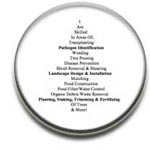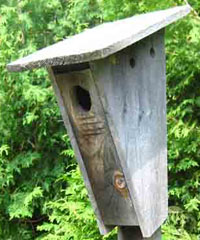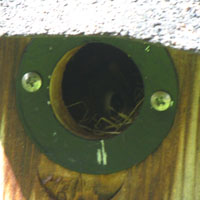 |  |
    
|

|
Entrance Hole |
|
The entrance hole should be large enough to admit the bird, but not so large as to admit unwanted species. If one wants to attract smaller songbirds, a 1½" diameter is a common size of entrance hole; however, it is an advantage to use a smaller size if you are planning to attract chickadees and wrens. Using a 11⁄8" entrance hole keeps other unfavourable species from using the entrance due to their larger body size. Red squirrels, (as seen in the picture to the right) are able to get into a 1½" hole, but not a 11⁄8" entrance hole. |
|
Roof Overhang |
 |
The roof should overhang the front of the birdhouse to limit the amount of rain that makes its way into the entrance hole. Negative effects from wind and sun can also be decreased with a proper roof overhang. Tin and asphalt shingle roofs should be avoided as they heat up greatly in the summer sun.
One of the distinguishing features of the Petterson Eastern Bluebird birdhouse is its large roof overhang (as seen to the left). |
Height Above GroundSpecific species of birds favour nesting in tree cavities at different heights although they will nest outside the favoured range depending on what is available in the area. |

©2014 Cranmer Earth Design ![]()
